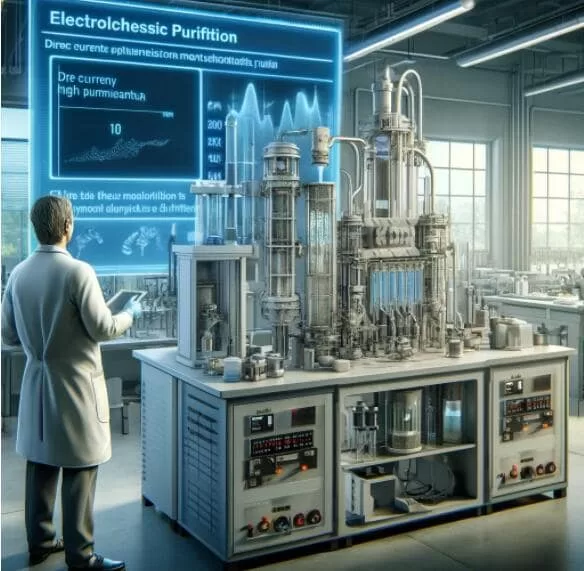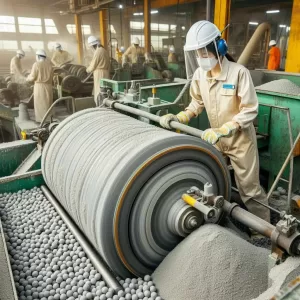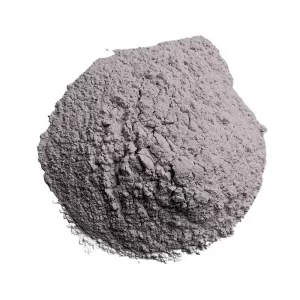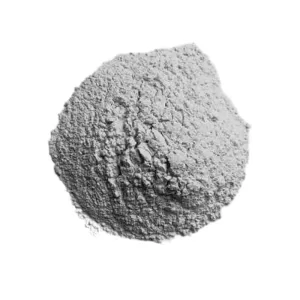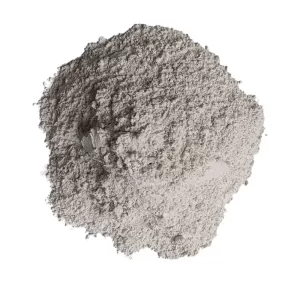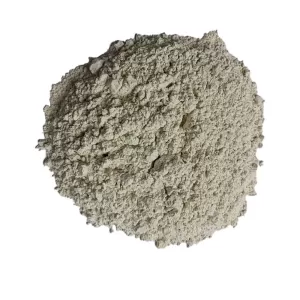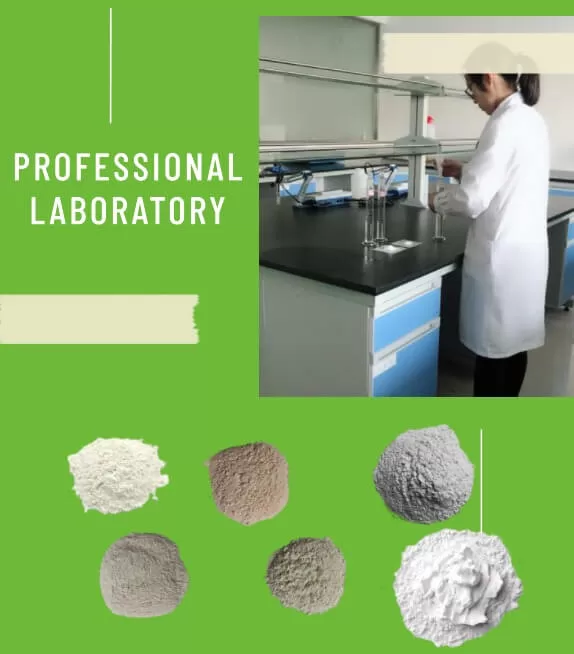Natural bentonite, generally low-grade, purified bentonite, can significantly broaden its application properties and areas. The purified bentonite is to continue to carry out further processing of important raw materials, especially nanocomposites, column-supported montmorillonite, cosmetic substrates, pharmaceuticals, and pharmaceutical excipients such as high, fine, sharp bentonite products, in many areas has shown a very prominent value of the application. Therefore, the purification of bentonite has a very considerable economic value.

Dry method
The dry method is to have been ground to a certain fineness of the bentonite ore and air fully mixed into the fluidisation; in the classification wheel centrifugal force and fan pumping force, most of the coarse particles and specific gravity of the particles and fine-grained minerals separated from the purification process—Wang et al. purified low-grade natural bentonite raw ore from a place in Xinjiang by dry method. After purification, the quality of montmorillonite can reach the standard requirements for the national sodium bentonite waterproof blanket. 1:1 industrial experimental programme results show that the finer the original ore grinding, the better the expansion properties of the purified product. The dry purification of bentonite requires less investment, lower purification costs than the wet process, fewer varieties of equipment, process simplicity, no sewage, and other advantages. In addition, the dry method has almost no water consumption and is suitable for water-scarce areas such as Xinjiang. However, the density difference between impurities and montmorillonite is very small. Dry grinding is not possible to fully dissociate the clay minerals and impurities. Hence, the separation of fine-grained impurities is difficult, the product quality is not high, and the quality of the product is not stable; it can only be used as a raw material for products that do not require a high degree of purity.
Wet method
In wet purification, the water medium for montmorillonite interlayer expansion and hydration provides enough space and power. Through stirring and adding dispersant, the montmorillonite colloidal particle size will be smaller, making it easier to achieve separation with impurity minerals that can not reach the colloidal particle size.
1. Natural sedimentation method
Bentonite will be made into a slurry, montmorillonite absorbs water and swells and is subjected to a greater buoyancy force than that of the non-expanding impurities, and montmorillonite is stratified with the impurities. On the other hand, according to Stokes’ formula, the rate of decline of the sphere in solution is proportional to the square of its radius, and some impurity minerals with a larger particle size than montmorillonite and a larger specific gravity than montmorillonite will sink more quickly. Therefore, the bentonite can be purified by removing the lower layer of impurities after standing for some time.
Wang Zemin et al. repeatedly used the natural sedimentation method to purify sodium bentonite, which substantially increased the content of montmorillonite. Studies have shown that the finer the mineral particle size, the purer the product.
Rong Kuiyi et al. believe that in the bentonite slurry, a large number of highly dispersed viscous particles with high viscosity, montmorillonite and impurity minerals interface viscous resistance hinders the separation of the two. At the same time, the charged montmorillonite wafers are interconnected to form an “I” structure to encapsulate the fine impurity minerals. Their tests showed that the addition of suitable dispersants can reduce the viscosity of the slurry, and phosphate dispersants can also change the charged nature of the surface of the montmorillonite so that the wafer layers repel each other. Thus, dispersants are often used to purify bentonite. Ye Lijia et al. selected sodium pyrophosphate, water glass, and sodium hexametaphosphate as a dispersant; the series of studies conducted showed that 0.5% sodium hexametaphosphate has the best results.
The natural sedimentation method can purify montmorillonite to a certain extent, is easy to operate, and has a low cost of purification. However, the natural sedimentation purification process requires a long settling time, the plant covers a large area, and the slurry interface needs to be clearer, resulting in unstable quality and other issues. And under the influence of viscous particles and impurity minerals interface viscous resistance, gravity decreases, resulting in montmorillonite and very fine impurity particle separation difficulties.
2. Hydraulic grading purification method
The hydro classification purification method uses hydro cyclone particles of different sizes to differentiate the settling speed and direction of movement and the المونتموريلونيت particles and impurity particles group separation to achieve hydro classification to purify bentonite.
Yang Youxue et al. carried out a four-stage sorting of bentonite slurry, and the montmorillonite content gradually increased with the sorting. Yinhang et al. used a cyclone to purify bentonite from a place in Xinjiang by cyclone grading several times. The results of the condition test showed that the higher the sorting pressure, the higher the montmorillonite content of the concentrate. Under the same pressure conditions, the sorting concentration is low, which is conducive to increasing montmorillonite content, but the recovery rate will be slightly reduced.
The hydraulic purification method desalination effect is obvious: the purification effect is better, the product quality is better, it is easy to achieve large-scale industrial production, and the purification process does not add chemical reagents, further purification can be used for the production of fine chemicals, daily necessities and pharmaceutical products. However, for fine-grained quartz and water-soluble salts and other impurities, the removal effect of the cyclone is limited.
3. Centrifugal purification method
The method uses bentonite suspension slurry under the action of centrifugal force. Particle size and density of impurity particles are thrown to the separation wall, settling to form slag, and the slag is separated so that الشركة المصنعة للبنتونيت is purified.
Ren Xin et al. introduced the commonly used decanter centrifuge, and its use in bentonite purification achieved good results. Zhang Xiaoman et al. Ezhou City, low-grade calcium-based bentonite as raw material centrifugal purification of bentonite to meet the indicators of casting and metallurgical pellets with quality indicators. Wu Zhan province, etc., through a series of tests to explore the centrifugal purification process in the solid-liquid ratio, pulping time, centrifugal time, and centrifugal speed on the effect of purification, and get the best combination of the process of Riyue mine bentonite. From the orthogonal experiment extreme difference analysis, the decisive factors affecting the purification are in the following order: pulping time > solid-liquid ratio > centrifugal speed > centrifugal time. China’s CN200780000799.2 patent provides a combination of centrifugal processes and other processes to produce high-purity montmorillonite.
The centrifugal purification process has the advantages of large production capacity, short purification time, continuous production, small equipment footprint, suitable for industrial production needs, stable quality of purified slurry, etc. Still, the yield is low, and it consumes a considerable amount of energy, and the purification cost is high.
4. Heavy liquid purification method
The principle of the heavy liquid purification method is to insert light molecules or molecular groups in the layers of montmorillonite crystals and increase the distance between the layers to reduce the density of montmorillonite. In contrast, the impurity minerals between the layers of the combination of solid, light molecules or molecular groups are difficult to enter; the density is almost unchanged to make montmorillonite, and the density of the impurity difference increases. The bentonite is purified by selecting a heavy liquid of suitable density and separating the impurities from the montmorillonite by stirring, oscillation, and centrifugation.
Loughnan carried out a study on the separation of montmorillonite and kaolinite using biomimetic alcohol and found the density of the heavy liquid that would float montmorillonite and kaolinite etc., respectively. He concluded that two main factors affected the separation: the ability of the mineral to absorb the alcohol and the particle size. For montmorillonite, etc., the decrease in density caused by the expansion of the laminae is the main factor. Particle size has a greater influence on minerals such as kaolinite, illite and quartz, which do not expand significantly.
X-ray diffraction analysis of Xuanhua natural montmorillonite dipped by 20% aqueous solution of n-octylamine by Kong Qingchi et al. proved that n-octylamine entered the interlayer. And CCl4 as a heavy liquid can make the n-octylamine aqueous solution of montmorillonite levitation, and non-expansive clay will not float into the montmorillonite, indicating that n-octylamine – CCl4 separation of montmorillonite is feasible. X-ray diffraction analysis of the purified bentonite showed weak impurity peaks and high purity of montmorillonite.
The heavy liquid used in the carbon tetrachloride heavy liquid method is toxic; alternative reagents must be found to improve this method. Duan Tiyu et al. introduced a new heavy liquid solution of sodium polytungstate, whose density varies from 1.0 to 3.1 g/cm3. They used sodium poly tungstate ultrasonic high-speed centrifugation method to separate and purify Jinyun zeolite and clay, and the effect was good. Sodium poly tungsten is a new type of inorganic heavy liquid which is non-toxic, stable, has a high recovery rate, and is easy and safe to use. The preparation of the solution is convenient, the density size is easy to control, and the separation of minerals with a small density difference has certain advantages, for the heavy liquid purification method provides broad application prospects.
5. Chemical purification method
Some low-grade natural bentonite often contains calcium carbonate, iron oxides and organic matter. Chi-NhanHaThuc et al. 0.1 mol / L of acetic acid to remove the carbonate in the bentonite in the two estates of LamDong and ThuanHai, Vietnam. The addition of H2O2 solution removed organic matter. Oxalic acid and 0.5 mol/L HNO3 were effective for iron oxides in bentonite.
6. Electrophoresis method
In the structure of natural double octahedral montmorillonite, there are homocrystalline substitutions of A1 and Mg to tetrahedral and octahedral sheets in the double octahedral layer, and it is this homocrystalline substitution that makes the montmorillonite interlayer and the end face with a negative charge [21]. Therefore, the bentonite slurry is electrophoresed with a DC, and the anodic liquid is collected and dehydrated to obtain fine clay.
Our CN200810109682.4 patent [22] uses electrophoresis to purify bentonite. The montmorillonite is crushed to less than 2 microns, electrophoresis montmorillonite slurry, and high purity montmorillonite can be obtained by dehydration. Nano montmorillonite and modified montmorillonite were purified by electrophoresis for higher product quality.
High-purity bentonite obtained by electrophoresis has significantly broadened the scope of use and greatly increased the added value. However, the method requires large power consumption, equipment investment, and purification costs, and the process needs to be mature.
Wet purification of bentonite needs to be solid-liquid slurry separation, specifically through natural evaporation, heating, centrifugation, filtration, flocculation and other methods. The natural evaporation production cycle should be shorter and conducive to large-scale production. Heating consumes a lot of energy, which is not conducive to energy saving and is expensive. China’s CN200810109682.4 patent provides a membrane filtration method, but the technique requires frequent cleaning of permeable membranes, and the process is complex, with obvious limitations. Adding flocculants can accelerate the bentonite aggregation and sinking. Still, the use of inorganic or organic flocculants will make the montmorillonite particles rapidly aggregated and tightened, the specific surface area becomes smaller, and part of the surface of the particles is covered by flocculants so that its expansion, adsorption, adhesion and other characteristics are reduced.
خاتمة
The following points determine bentonite purification methods and processes:
(1) the type of impurities in the bentonite, the particle size of the impurities;
(2) The use of bentonite and the purity requirements;
(3) the cost of the purification process.
Industrial production should consider the above factors, select the appropriate method, choose a variety of methods for scientific combinations, and use reasonable and comprehensive procedures to obtain a variety of purity of bentonite to meet the needs of different product uses. At the same time, we should fully use low-purity bentonite, quartz, kaolinite and other by-products of purification to achieve the multi-level use of resources and zero discharge of tailings.
With the development of science and technology and modern industry, people have higher and higher requirements for the purity of bentonite. However, obtaining obtaining high purity bentonite and the purification process applied to large-scale industrial production still needs to be improved. The reason is that, on the one hand, the chemical composition of montmorillonite and associated minerals impurities are very close to the particle size, and the density difference is very small; on the other hand, the distribution of bentonite particles is mainly in the <2μm, and 10 ~ 15μm section and the size of the very small particles of the specific surface area is larger, with a significant surface effect, the surface energy increases. Therefore, the separation force provided by the general purification process makes it difficult to effectively balance the mutual attraction between montmorillonite and impurity particles and separate the two. The author believes that the purification process to obtain high-purity bentonite development trend, first, further in-depth exploration of the conditions of the purification process and the relevant parameters, optimise the existing process so that it is from crude to refined. The second is the development of new processes that have the potential to be applied to industrial production.

